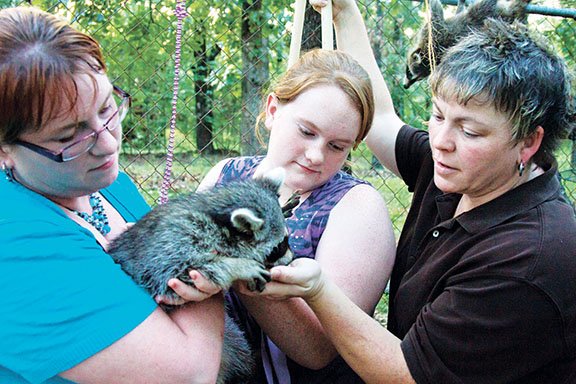CABOT — It might seem that a cute, cuddly and seemingly tame animal would make a good pet, but some animals need to remain in the wild.
Unfortunately, sometimes people pick up a raccoon or a coyote, thinking it will fit in like a cat or dog, then are at a loss when the animal exhibits disruptive behavior.
That’s how Angela Spears came to have Scratch, a raccoon. Spears is a permitted animal rehabilitator with the Arkansas Game and Fish Commission, and Scratch is one of the animals currently in her care.
“They are not pets,” she said. “I get more people contacting me who have had a raccoon for a year and then turn them over when they go into heat. They are meant to be wild.”
Scratch will take time to rehabilitate, Spears said, because he was raised as a pet and does not have the natural caution against humans that most raccoons have.
Spears is also caring for two other raccoons — Simon and Garfunkel — who are more standoffish toward humans. Simon was found alone huddled against a house, and Garfunkel’s mother was trapped and moved by someone who did not check for babies.
“Sometimes when we get close, they start hissing,” she said of Simon and Garfunkel. “And that’s a good sign. That’s what’s supposed to happen.”
Spears and her wife, Charlie, work with their daughters, Becca and Morgan, to rehabilitate the animals.
The family is taking care of three deer, in addition to Scratch, Simon and Garfunkel. In the past four years as a permitted animal rehabilitator, Spears and her family have helped several raccoons, eight deer, two coyotes, three foxes, a beaver, two minks, several possums and several squirrels.
“I feel obligated because they’re lacking what they need because we tore their trees down,” Spears said. “We are the ones who took away their resources and their homes.”
Morgan, 13, is the main family member to work with the deer. Limited human contact makes the release of deer at the end of their rehabilitation easier, and Morgan has a knack for deer nurturing.
One way deer end up in rehabilitation is if they are taken away from their mothers by people who are trying to do the right thing. Morgan said a mother deer will leave her baby in a set location in order to search for food. The baby is not lost or in danger when the mother is nearby, but sometimes humans with good intentions will take the baby deer, thinking it has been abandoned or is in trouble.
“If you see a baby deer, don’t pick it up. Momma’s there,” Morgan said. “She’s probably watching you.”
Spears said that if someone sees a baby deer and is concerned, he or she should note where they saw the deer and check back later.
“Generally, the rule is it’s not abandoned unless it’s been screaming for 12 hours,” she said. “The mother deer is probably there and wondering what you’re doing with her baby.”
For anyone who does find an abandoned wild animal and wants to help, Spears suggests calling a permitted animal rehabilitator who knows how to care for the animal. Moving an animal — especially a baby — could separate it from its family. Feeding an animal right away is one example of something that seems correct but can be devastating. The animal needs to be warmed up first, but it is hard to know those kinds of things without specific training or research.
“It’s all good intentions,” Spears said. “People just don’t know.”
As a volunteer, Spears is only able to take in a limited number of animals because of space and money constraints. She said she gets donations of produce to supplement what she grows in her garden and utilizes donated chain-link fence, wood and other material to build enclosures.
Another major need is donated goat milk. Spears said the baby deer need specific nutrients found in goat milk — which is similar to the nutrients they would receive from their mothers — in order to thrive.
Spears lives in Cabot and can be contacted at (501) 259-0241. For a list of animal rehabilitators, visit www.agfc.com/species/Documents/rehabilitators_by_county.pdf.
Staff writer Angela Spencer can be reached at (501) 244-4307 or aspencer@arkansasonline.com.
